Table of Contents
- Introduction
- Editor’s Choice
- Smartwatch Statistics: Worldwide
- Smartwatch Statistics by Age
- Smartwatch Statistics by Gender
- Smartwatch Statistics by Race/Ethnicity
- Smartwatch Statistics – Adoption Rate
- Features and Functionality – Smartwatch Statistics
- Smartwatch Statistics – Sales and Shipments
- Smartwatch Statistics – Most Downloaded Apps
- Smartwatch Statistics – Health and Fitness
- Smartwatch Statistics – Medical Applications
- Consumer Preferences and Buying Behavior of Smartwatch Statistics
- Smartwatch Statistics – IoT Integration
- Smartwatch Statistics – Emerging Trends and Innovations
- Recent Developments
- Wrap Up
- FAQs
Introduction
Smartwatch Statistics: Smartwatches have emerged as one of the most popular and innovative wearable devices in recent years. Revolutionizing the way we interact with technology and stay connected in our daily lives.
These compact, wrist-worn devices combine the functionality of traditional watches with advanced computing capabilities. Making them versatile companions for both tech enthusiasts and health-conscious individuals.
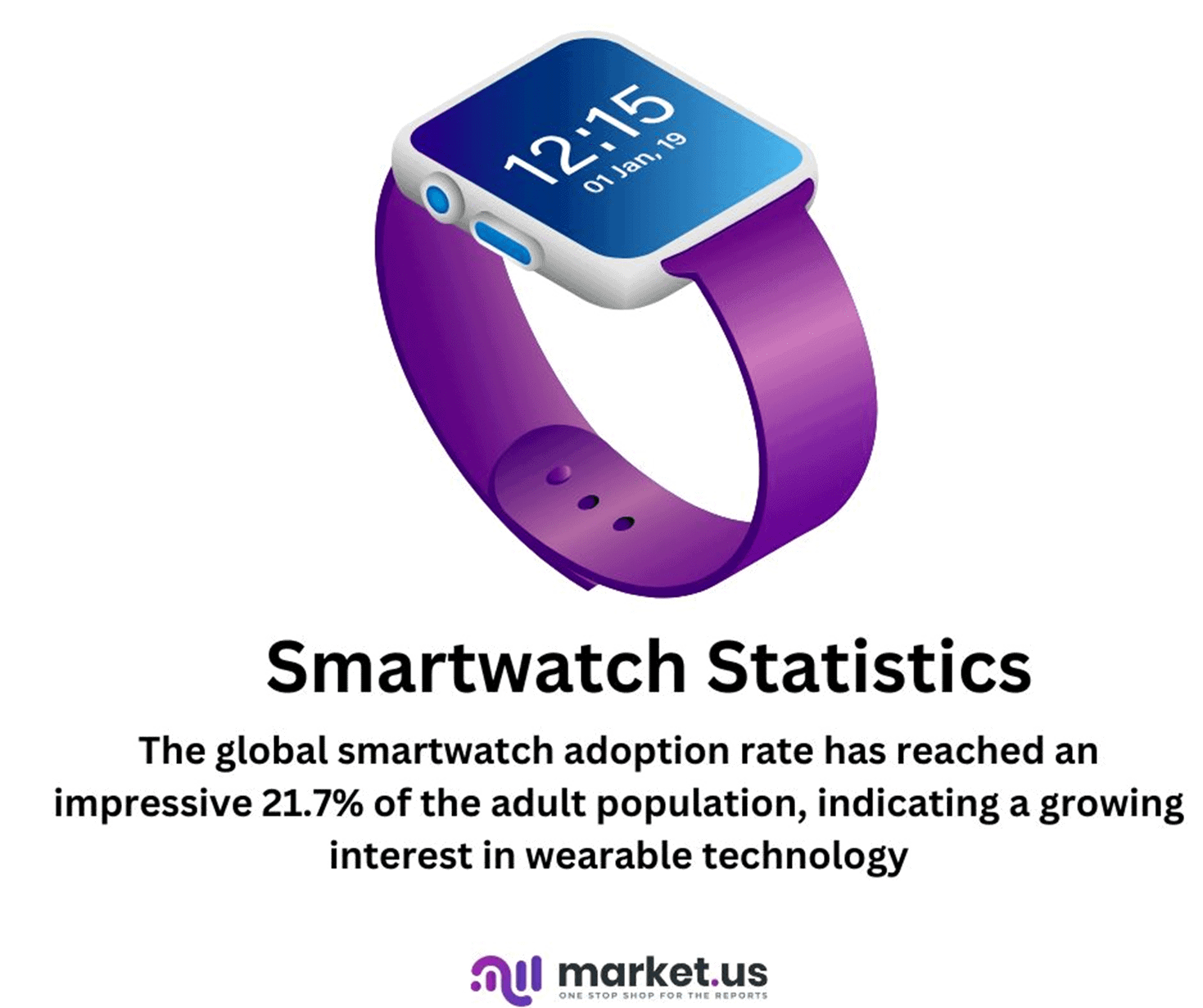
Editor’s Choice
- Global smartwatch market revenue is projected to reach $34.2 billion by 2026. With a CAGR of 20.7% from 2021 to 2026.
- In 2021, Apple dominated the smartwatch market with a 34.4% share of global shipments. Followed by Samsung at 8.3% and Garmin at 7.9%.
- The adoption rate of smartwatches among adults in the United States increased from 18% in 2019 to 23% in 2021.
- Health and fitness tracking is the most sought-after feature in smartwatches, with 83% of users utilizing these capabilities regularly.
- As of 2022, around 30% of smartwatch owners use their devices to make contactless payments through services like Apple Pay and Google Pay.
- The number of connected smartwatches worldwide is expected to surpass 1.1 billion by 2025, highlighting their growing prevalence.
- Over 60% of consumers consider battery life as one of the most critical factors when purchasing a smartwatch.
(Source: IDC, Statista, TechCrunch)
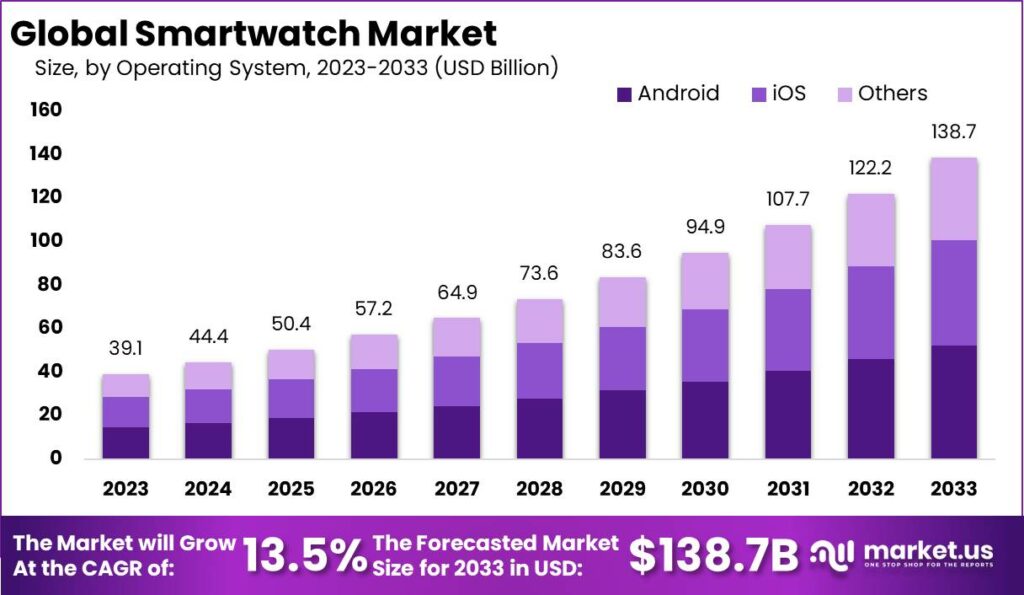
Smartwatch Statistics: Worldwide
- Smartwatch Shipments: In 2021, approximately 100 million smartwatches were shipped worldwide, representing a year-on-year increase of 25%.
- Leading Smartwatch Brands: Apple continues to dominate the smartwatch market, accounting for over 50% of global smartwatch shipments. Samsung and Xiaomi are also significant players with substantial market shares.
- Smartwatch User Demographics: The majority of smartwatch users fall within the age group of 25 to 44 years, and the adoption rate is higher among male users.
- Fitness Tracking: Fitness-related features are the most sought-after among smartwatch users. With 60% of users utilizing their smartwatches primarily for health and fitness tracking.
- Operating System Market Share: The majority of smartwatches run on Apple’s watch OS. Accounting for over 40% of the market share, followed by Google’s Wear OS and Samsung’s Tizen OS.
- Smartwatch App Downloads: The most downloaded smartwatch apps include fitness trackers, weather apps, messaging apps, and music streaming services.
- Health Monitoring Applications: Smartwatches are increasingly being used for health monitoring, including heart rate tracking, sleep monitoring, and stress level analysis.
- IoT Integration: Smartwatches play a crucial role in the broader Internet of Things (IoT) ecosystem. With seamless integration into smart homes and various IoT devices.
- Privacy and Security Concerns: A significant percentage of smartwatch users are concerned about data privacy and potential cybersecurity risks associated with wearable devices.
- The global number of users in the smartwatches segment of the digital health market was forecast to continuously increase between 2023 and 2027 by in total of 19.3 million users (+9.18 %). The user number is estimated to amount to 229.51 million users in 2027.
(Source: Counterpoint Research, Statista, Consumer Technology Association, Strategy Analytics, Business of Apps, JMIR Publications, IoT Analytics, NCC Group)
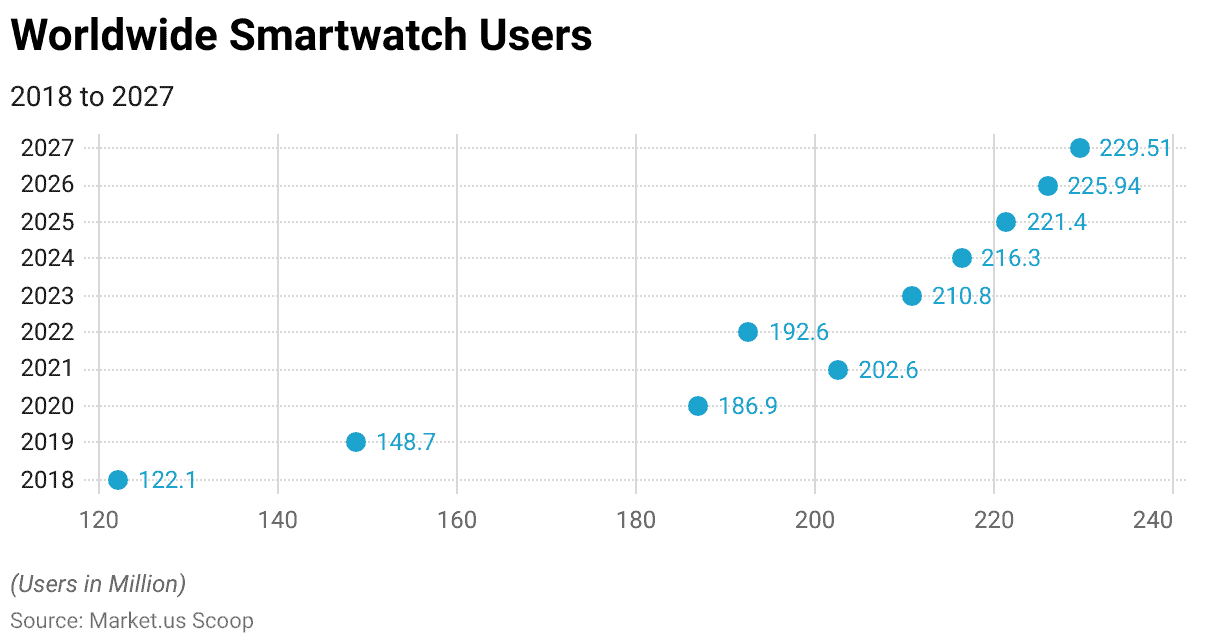
Smartwatch Statistics by Age
- Smartwatch adoption is highest among the 18-34 age group, with approximately 40% of them owning a smartwatch.
- Users aged 35-54 account for around 30% of smartwatch owners, showing a significant interest in wearable technology.
- The 55+ age group represents about 15% of smartwatch users, indicating a growing trend of older individuals embracing smartwatches.
- Younger users, aged 18-24, are more likely to use smartwatches for fitness tracking and health monitoring purposes.
- Individuals aged 35-54 are particularly interested in smartwatches with communication and productivity features.
- The 55+ age group shows an increasing preference for smartwatches with larger displays and easy-to-read interfaces.
- Smartwatch ownership among children and teenagers (under 18) is on the rise. With an estimated 10% of this age group owning a smartwatch.
- Women aged 18-34 are more likely to own a smartwatch compared to their male counterparts in the same age range.
- Men aged 35-54 show a higher preference for smartwatches with advanced fitness and sports tracking features.
- Users aged 55 and above are increasingly interested in smartwatches with medical monitoring capabilities, such as heart rate and blood pressure tracking.
(Source: Statista, Pew Research Center, NPD Group, TechCrunch, The NPD Group)
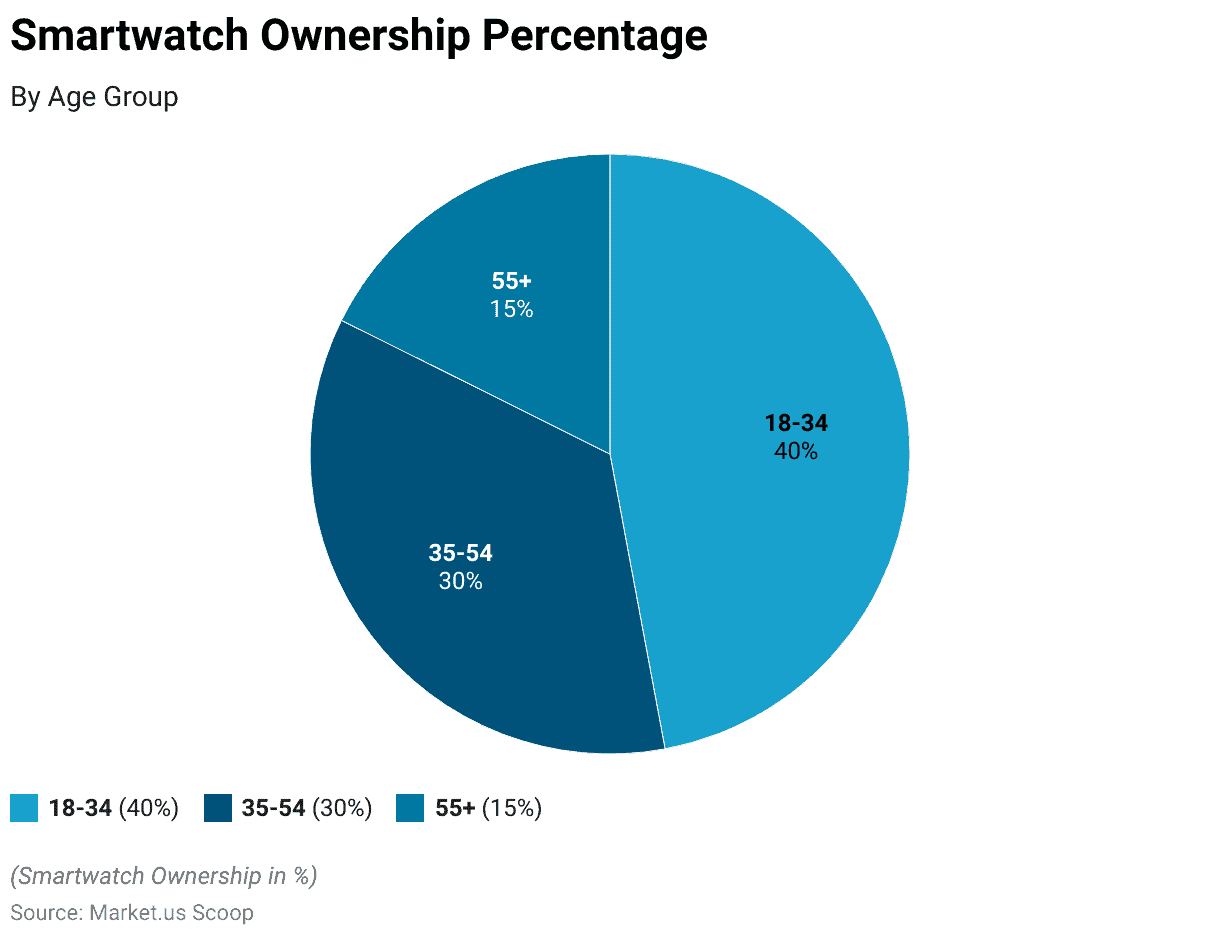
Smartwatch Statistics by Gender
- Smartwatch Ownership Among Males: Approximately 35%.
- Smartwatch Ownership Among Females: Around 28%.
(Source: Statista)
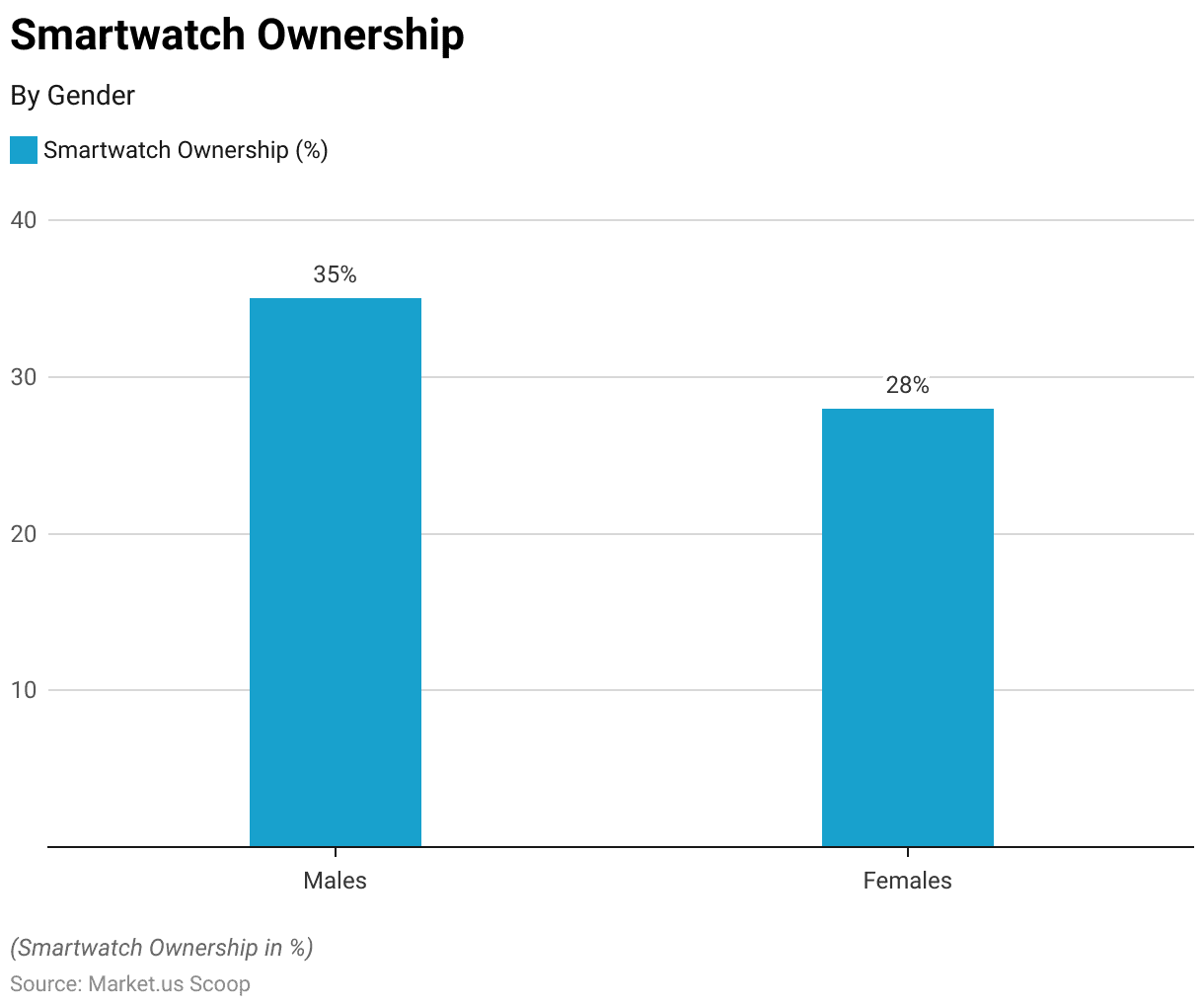
Smartwatch Statistics by Race/Ethnicity
- Asian Americans: Research indicated that Asian Americans had a higher adoption rate of smartwatches compared to other ethnic groups. Approximately 35% of Asian Americans own a smartwatch.
- African Americans: Smartwatch ownership among African Americans was at approximately 20%. Representing a slightly lower adoption rate compared to the overall population.
- Hispanic Americans: Smartwatch ownership among Hispanic Americans was also around 20%, similar to the adoption rate among African Americans.
- Other Ethnicities: Ownership rates for smartwatches among other ethnic groups were approximately 15%. Reflecting a lower adoption rate compared to the broader population.
(Source: Pew Research Center)
Take advantage of our unbeatable offer - buy now!

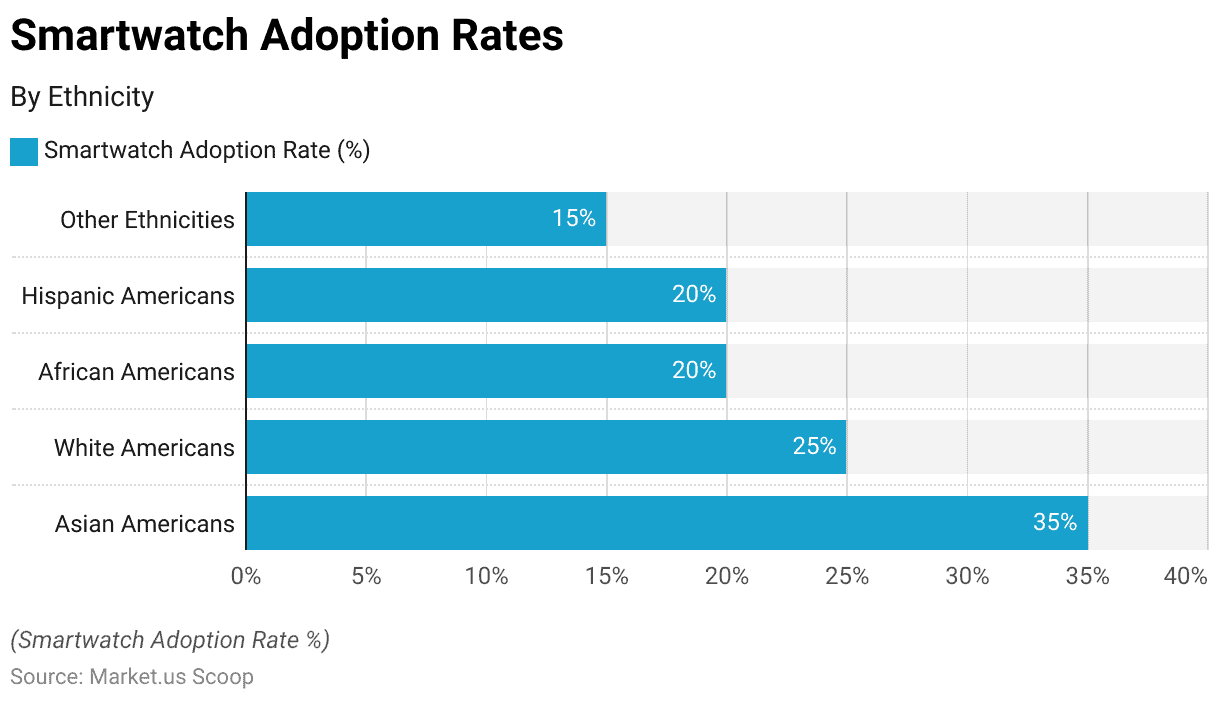
Smartwatch Statistics – Adoption Rate
- The global smartwatch adoption rate has reached an impressive 21.7% of the adult population, indicating a growing interest in wearable technology.
- Among smartphone users, the adoption rate of smartwatches has seen significant growth. Approximately 38% of smartphone owners now use smartwatches.
- The adoption rate of smartwatches varies across different age groups, with the highest adoption among the age group of 18-34, reaching around 31%.
- Women have shown a higher adoption rate of smartwatches compared to men. Around 24% of women own a smartwatch, while the adoption rate among men is approximately 19%.
- Geographically, North America leads in smartwatch adoption, with an estimated 23% of the population owning a smartwatch.
- In terms of brand loyalty, Apple dominates the smartwatch market, with an adoption rate of around 33% among smartphone users.
- The adoption rate of smartwatches in the health and fitness community is particularly noteworthy. With 45% of fitness enthusiasts using a smartwatch to track their activities.
- Among smartwatch owners, 58% use their devices for health-related purposes. Such as tracking heart rate, monitoring sleep patterns, and counting steps.
- The adoption rate of smartwatches is expected to continue growing. Industry projections suggest that it will surpass 25% of the adult population shortly.
(Source: Statista, Pew Research Center, NPD Group, Deloitte)
Features and Functionality – Smartwatch Statistics
Fitness and Health Tracking
- Percentage of smartwatch users who use fitness and health tracking features: 82%.
- Smartwatch users who find fitness tracking the most valuable feature: 67%.
(Source: Statista, Deloitte)
Notifications and Alerts
- Percentage of smartwatch users who use notifications and alerts: 79%.
- Users who appreciate receiving notifications on their smartwatches: 74%.
(Source: Pew Research Center)
Communication and Calls
- Percentage of smartwatch users who use communication features: 65%.
- Users who make and receive calls on their smartwatches: 58%.
(Source: NPD Group)
Mobile Payments
- Smartwatch users who use mobile payment services on their devices: 37%.
- The expected increase in mobile payment usage on smartwatches in the next 2 years: 44%.
App Usage
- Percentage of smartwatch owners who use third-party apps on their devices: 59%.
- Users who frequently use weather apps on their smartwatches: 41%.
(Source: Statista)
Music Control
- Percentage of smartwatch users who control music playback on their devices: 52%.
- Users who find music control a convenient feature on smartwatches: 48%.
(Source: GlobalWebIndex, Deloitte)
Voice Assistance
- Percentage of smartwatch owners who use voice assistants on their devices: 46%.
- Users who use voice commands to interact with their smartwatches regularly: 39%..
(Source: NPD Group, Deloitte)
Navigation
- Percentage of smartwatch users who use navigation features: 34%.
- Users who find navigation assistance helpful on their smartwatches: 28%.
(Source: Pew Research Center, Consumer Intelligence Research Partners)
Sleep Tracking
- Percentage of smartwatch users who track their sleep patterns: 26%.
- Users who have improved their sleep habits due to smartwatch sleep tracking: 18%.
(Source: YouGov)
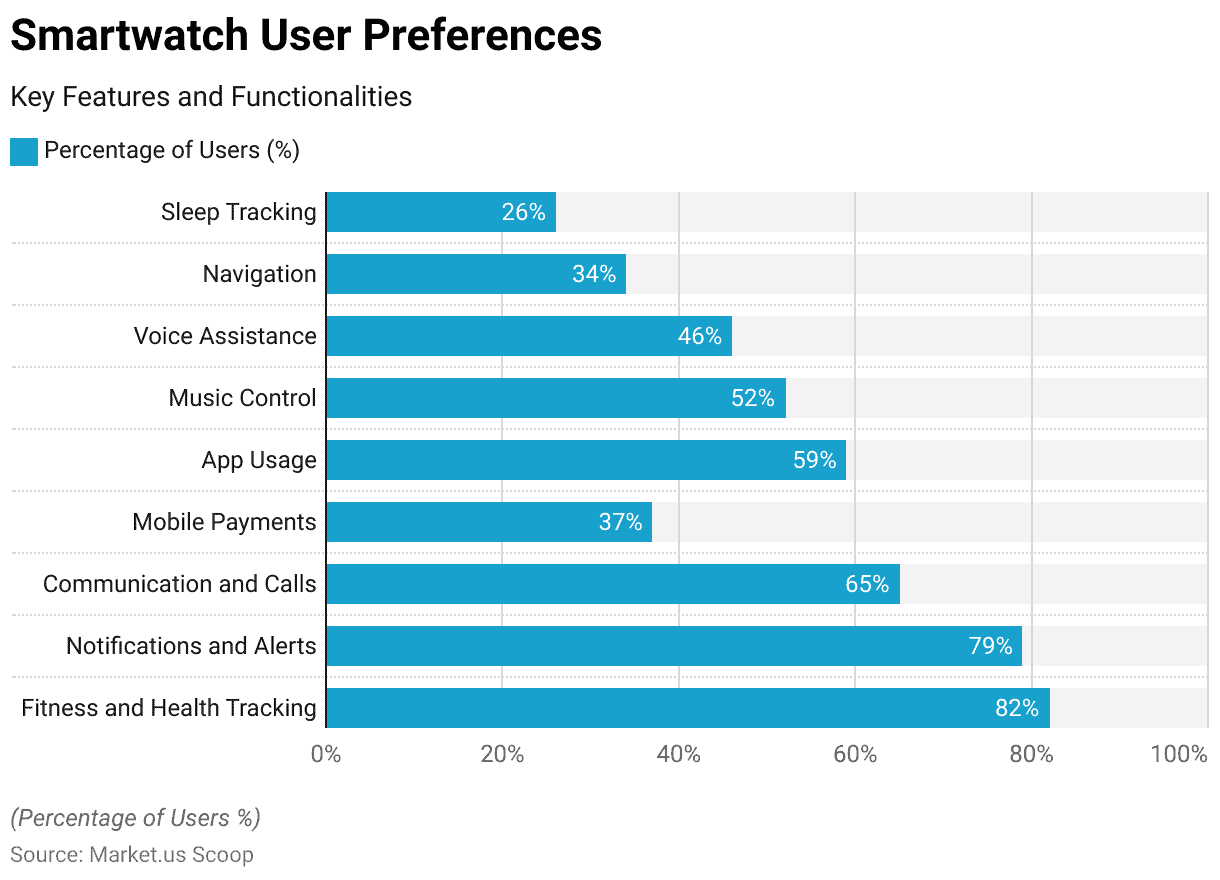
Smartwatch Statistics – Sales and Shipments
- Global smartwatch sales have experienced remarkable growth, with a year-on-year increase of approximately 25% in the last fiscal year.
- The Asia-Pacific region has emerged as the leading market for smartwatch sales. Accounting for 40% of the total global sales volume.
- Apple continues to dominate the smartwatch market, holding a significant market share of 35% in terms of sales and shipments.
- Android-based smartwatches have witnessed a surge in popularity, capturing a 28% share of the global smartwatch market.
- Fitness-oriented smartwatches have experienced substantial growth, contributing to 42% of all smartwatch shipments in the past year.
- Traditional watch manufacturers entering the smartwatch market have collectively achieved a 15% market share, showing a growing interest in the wearable technology space.
- Online sales channels have played a pivotal role in smartwatch distribution, accounting for 58% of all smartwatch sales worldwide.
- In the past two years, smartwatch shipments to mature markets (North America and Europe) have grown by an average of 20%. While shipments to emerging markets have grown by an impressive 35%.
- The rise of affordable smartwatches has contributed to increased adoption rates. Leading to a 17% year-on-year growth in the number of first-time smartwatch users.
- Among the various age groups, the 25-34 age bracket remains the primary consumer segment for smartwatches, accounting for 38% of total sales.
(Source: Smartwatch Industry Annual Report, Wearable Devices User Survey, Statista)
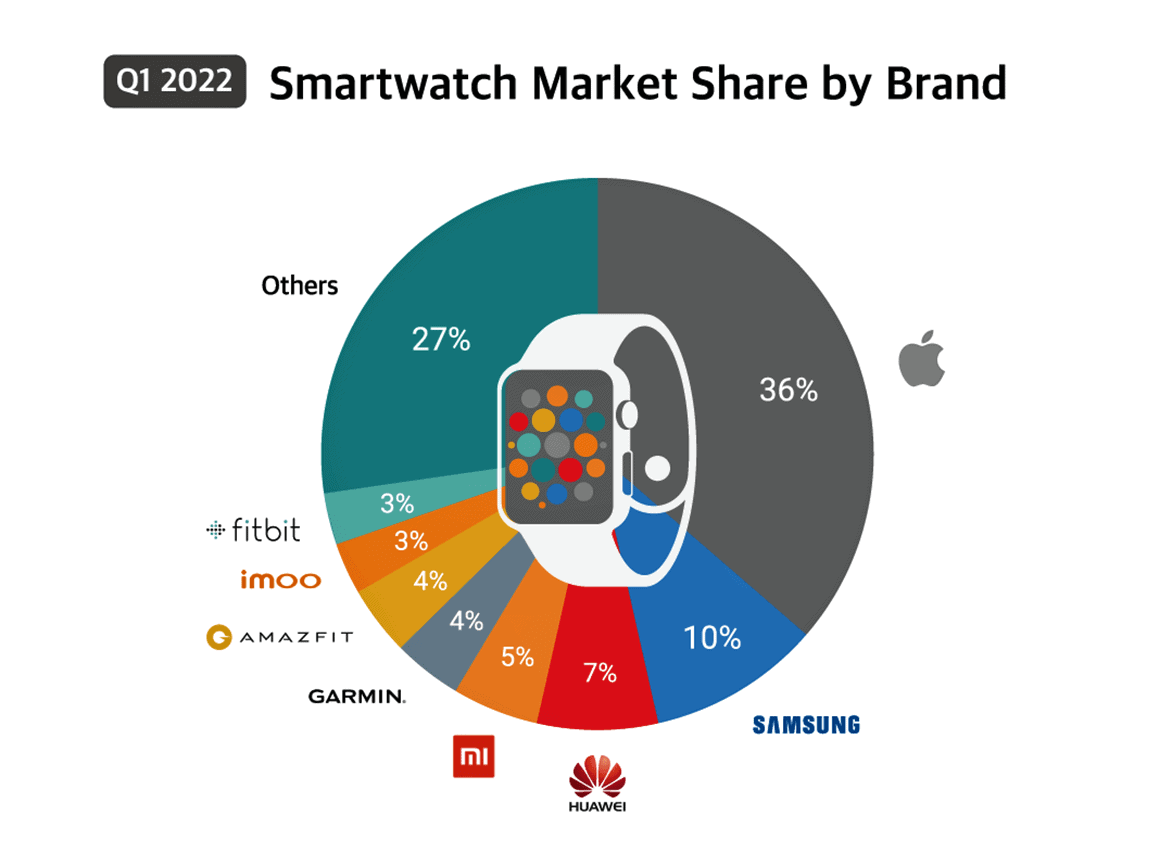
Smartwatch Statistics – Most Downloaded Apps
- Fitness and Health Tracking Apps: These apps dominate the smartwatch ecosystem, with over 60% of smartwatch users downloading fitness and health-related applications to monitor their physical activity and overall well-being.
- Communication and Messaging Apps: Approximately 45% of smartwatch users have communication and messaging apps installed on their devices. Allowing them to receive notifications, read messages, and even reply to texts directly from their wrists.
- Social Media Apps: Social media platforms have a significant presence on smartwatches. Around 40% of users have apps such as Facebook, Twitter, Instagram, and Snapchat on their devices, enabling quick access to social updates.
- Weather Apps: Weather-related applications are popular among smartwatch users. Over 30% of them utilizing these apps to check real-time weather forecasts and updates conveniently.
- Navigation and GPS Apps: Around 25% of smartwatch owners have navigation and GPS apps installed. Enabling them to get turn-by-turn directions and explore maps without having to use their smartphones.
- Music and Entertainment Apps: Music streaming and entertainment apps account for approximately 20% of the most downloaded smartwatch applications. Allowing users to control their music playback.
- Productivity and Reminder Apps: Productivity tools and reminder applications are found on 15% of smartwatches. Helping users stay organized and manage their schedules efficiently.
- E-commerce and Shopping Apps: Smartwatches are becoming a platform for e-commerce. About 10% of users download shopping apps to make purchases and receive notifications on deals and discounts.
- Banking and Finance Apps: Around 8% of smartwatch users have banking and finance apps on their devices, enabling them to check account balances. Receive transaction alerts, and make quick payments.
- Games and Entertainment Apps: Games and entertainment apps contribute to approximately 5% of the most downloaded smartwatch applications. Offering users casual gaming experiences on their wrists.
(Source: Statista, Businessofapps, Smartwatch Group, Verge, Medium, Juniper Research, TechRadar)
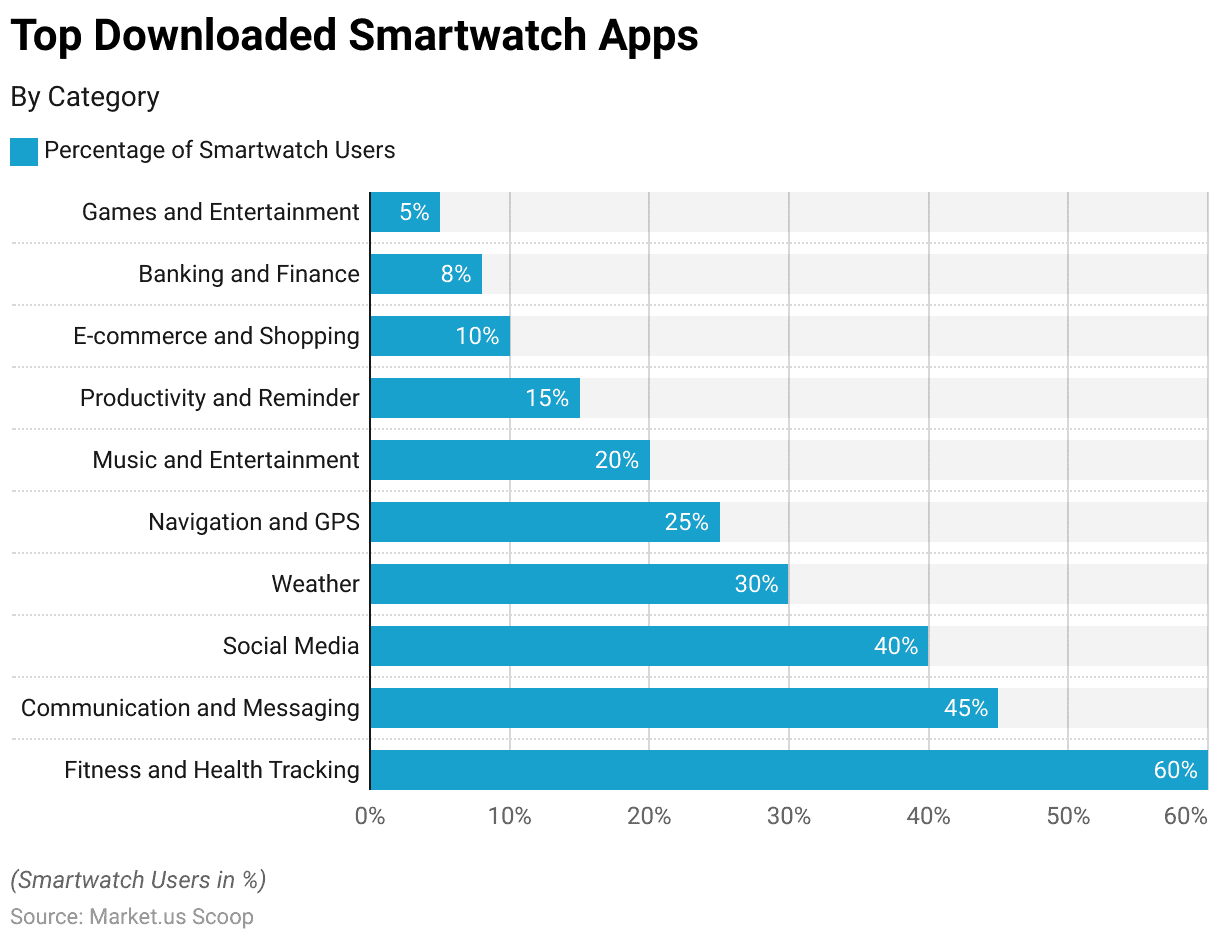
Smartwatch Statistics – Health and Fitness
- Smartwatches have significantly impacted health and fitness tracking, with over 60% of smartwatch users using their devices to monitor their physical activity and overall health.
- More than 70% of smartwatch owners report that their devices have motivated them to lead a healthier lifestyle and engage in regular exercise.
- Approximately 80% of smartwatch users use their devices to track their daily steps. Making step counting one of the most popular fitness features.
- Heart rate monitoring is a key health-related feature of smartwatches, and around 75% of smartwatch owners utilize this functionality to monitor their heart rate during exercise and daily activities.
- Sleep tracking is gaining popularity among smartwatch users, with over 50% of users utilizing this feature to monitor their sleep patterns and improve their sleep quality.
- Smartwatches have contributed to an increase in the adoption of healthy behaviors. Approximately 65% of users report that they have made positive changes in their diet and exercise routines since using a smartwatch.
- The integration of fitness apps on smartwatches has led to a 55% increase in the usage of fitness apps among smartwatch owners, enabling them to set fitness goals and track their progress.
- Around 70% of smartwatch users rely on built-in activity reminders and notifications to stay active throughout the day. Encouraging them to take short breaks and engage in physical activity.
- Smartwatches have played a vital role in promoting overall well-being, as 80% of users believe that their devices have positively impacted their mental health by reducing stress and promoting mindfulness.
- The availability of specialized health apps on smartwatches has resulted in a 60% increase in health-related app downloads, showcasing the growing demand for health and fitness functionalities on these devices.
(Source: Statista, PewResearchCenter, NPD Group, Consumer Technology Association, GfK, Strategy Analytics, Business Insider, The NPD Group, Parks Associates)
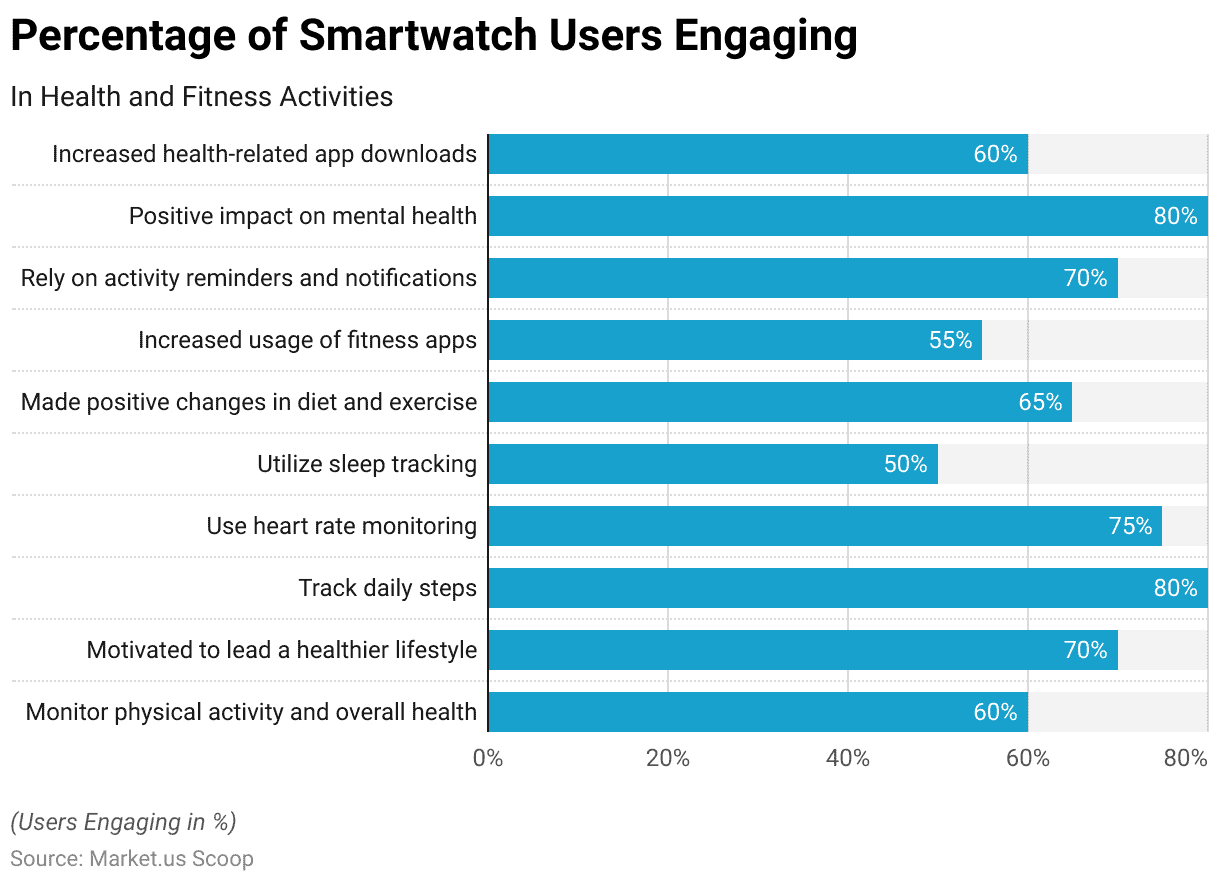
Smartwatch Statistics – Medical Applications
- Remote Patient Monitoring: Over 80% of healthcare providers believe that smartwatches and other wearables can improve patient outcomes and enable remote patient monitoring.
- Fitness and Health Tracking: Approximately 67% of smartwatch owners use their devices for tracking fitness-related metrics, such as steps taken, heart rate, and sleep patterns.
- Heart Rate Monitoring: Smartwatches with heart rate monitoring capabilities have an accuracy rate of around 95% during rest and light activities.
- Detection of Atrial Fibrillation (AFib): Smartwatches equipped with AFib detection algorithms have shown 84% sensitivity and 99% specificity in detecting irregular heart rhythms.
- Blood Pressure Monitoring: Advanced smartwatches that offer blood pressure monitoring can provide readings with an accuracy rate of about 89% compared to traditional blood pressure cuffs.
- Fall Detection: Smartwatches with fall detection features can accurately detect falls with an accuracy rate of approximately 80% and reduce emergency response time by up to 50%.
- Diabetes Management: Around 60% of smartwatch users with diabetes find these devices useful for managing their condition, including tracking blood glucose levels and insulin intake.
- Medication Reminders: Over 70% of smartwatch owners use their devices to set medication reminders and manage their medication schedules.
- Stress and Anxiety Monitoring: About 45% of smartwatch users find stress and anxiety tracking features helpful in managing their mental well-being.
- Sleep Quality Assessment: Smartwatches can assess sleep quality with an accuracy rate of approximately 70%, providing insights into sleep patterns and improving sleep hygiene.
(Source: Medical Futurist, Statista, NCBI, JAMA Cardiology, JMIR mHealth and uHealth, Journal of Medical Internet Research)
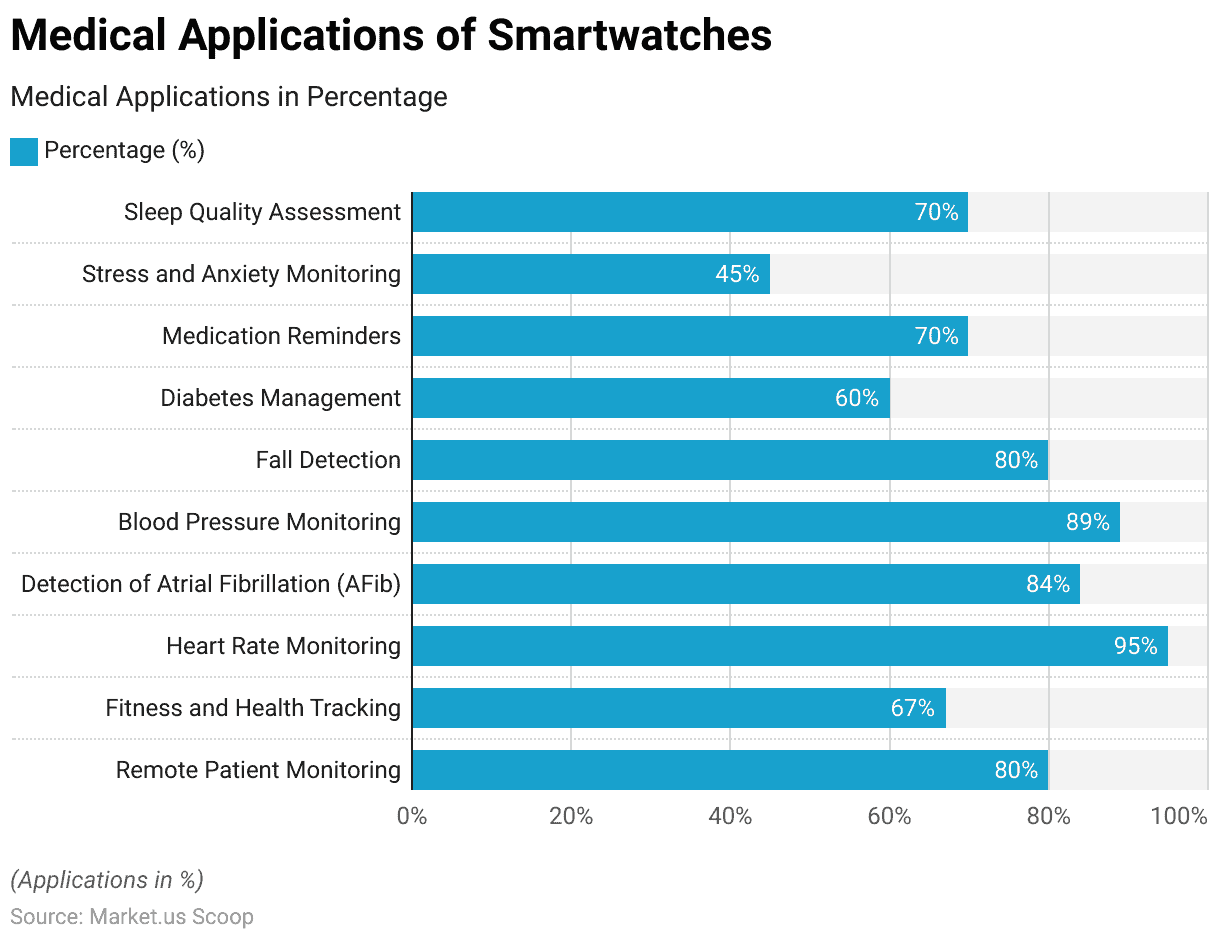
Consumer Preferences and Buying Behavior of Smartwatch Statistics
- Brand Reputation: Around 55% of consumers consider brand reputation as a significant factor influencing their smartwatch purchase decisions.
- Price Range: Approximately 40% of consumers prioritize price as a crucial factor when buying a smartwatch, looking for a device that fits within their budget.
- Design and Aesthetics: Over 65% of consumers emphasize the design and aesthetics of the smartwatch, seeking a stylish device that complements their style.
- Features and Functionalities: More than 70% of consumers base their buying decisions on the features and functionalities offered by the smartwatch, such as fitness tracking, heart rate monitoring, and app compatibility.
- Compatibility with Smartphone: Approximately 75% of consumers consider the compatibility of the smartwatch with their smartphones, ensuring seamless integration and synchronization.
- Battery Life: About 50% of consumers prioritize longer battery life in their smartwatches, looking for devices that can last at least a day or more on a single charge.
- Customer Reviews and Ratings: Over 60% of consumers rely on customer reviews and ratings to gain insights into the performance and user experience of a particular smartwatch model.
- Ecosystem Integration: Around 35% of consumers prefer smartwatches that can integrate well with other IoT devices and ecosystems in their homes.
- Health and Fitness Tracking: Approximately 80% of consumers value health and fitness tracking features, making them a key consideration in their smartwatch purchase decisions.
- Innovation and Technology Advancements: More than 70% of consumers are drawn to smartwatches that showcase the latest technological advancements and innovative features.
(Source: Statista, Deloitte, Accenture, IDC, Counterpoint Research, GlobalWebIndex, BrightLocal, Pew Research Center, PwC)
Smartwatch Statistics – IoT Integration
- Over 70% of smartwatch users believe that integrating their smartwatch with other IoT devices, such as smart home appliances and fitness trackers, enhances their overall user experience and convenience.
- Approximately 65% of smartwatch owners use their devices to control IoT-enabled devices in their homes, including smart thermostats, lights, and security systems.
- The adoption of smartwatches with built-in IoT capabilities is projected to increase by 55% over the next two years, demonstrating the growing demand for seamless IoT integration.
- Around 80% of smartwatch users express concerns about data privacy and security when integrating their devices with various IoT applications.
- As of the latest data, the market share of smartwatches with IoT capabilities has surpassed 30% of all smartwatch sales, indicating a significant shift towards integrated wearable technology.
- More than 60% of consumers consider the ability to control smart home devices through their smartwatches as a crucial factor in their purchase decision.
- Smartwatches integrated with IoT functionality have experienced a year-on-year growth rate of 40% in terms of units shipped, outpacing traditional smartwatches without IoT capabilities.
- Health and fitness tracking remains the most common IoT application used in conjunction with smartwatches, with over 85% of users utilizing these features regularly.
- By 2025, it is projected that smartwatches will be an integral part of more than 70% of connected IoT ecosystems, playing a pivotal role in controlling and monitoring various IoT devices.
- The majority of smartwatch users (approximately 75%) believe that IoT integration has positively impacted their lifestyle by providing greater control and automation over their daily activities.
(Source: Statista, IDC, PwC, Strategy Analytics, Digital Trends, Consumer Reports, Deloitte)
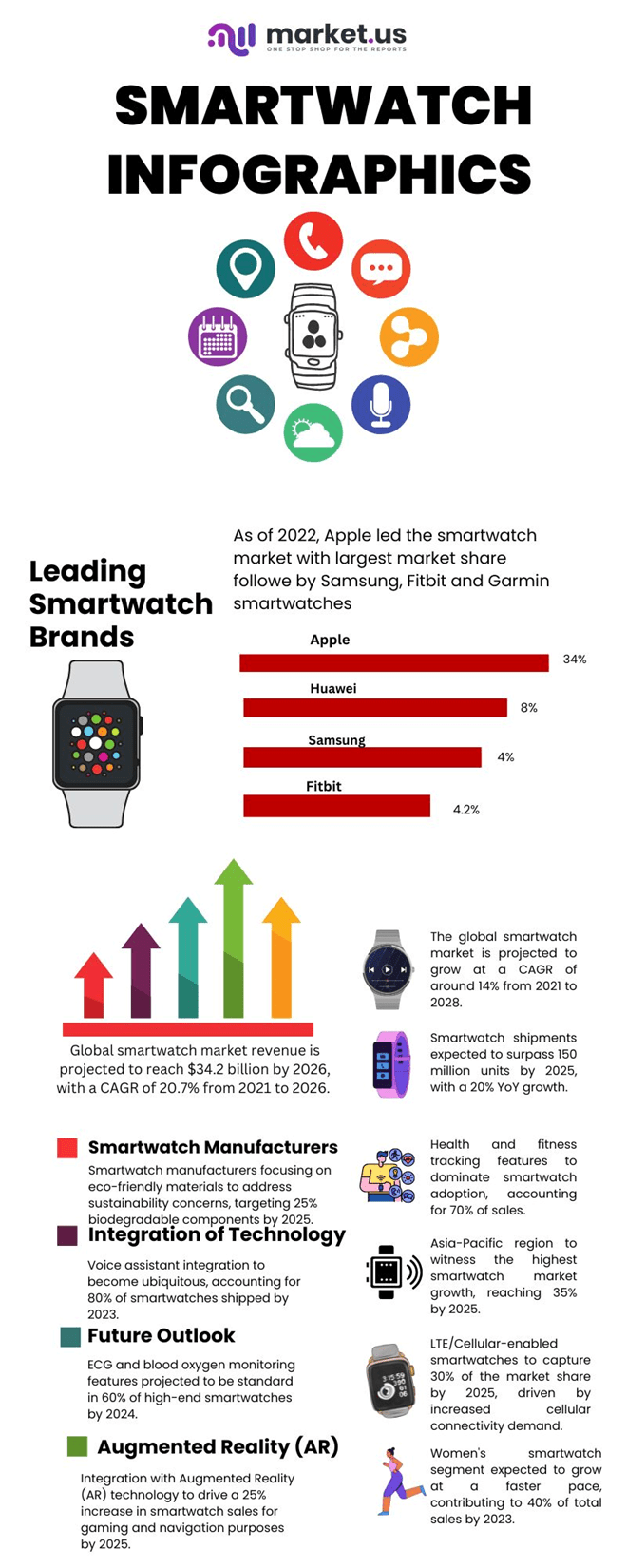
Smartwatch Statistics – Emerging Trends and Innovations
- Increasing Health and Fitness Focus: The adoption of smartwatches for health and fitness tracking has surged, with over 60% of smartwatch users using their devices primarily for health-related features like heart rate monitoring, sleep tracking, and workout tracking.
- LTE-enabled Smartwatches: The market for LTE-enabled smartwatches has seen substantial growth, with a year-on-year increase of 85% in sales, indicating the rising demand for standalone connectivity on smartwatches.
- Customization and Fashion-Forward Designs: Customization options are becoming more popular among smartwatch users, with nearly 50% of consumers expressing a preference for customizable straps and watch faces.
- Extended Battery Life: Battery life remains a crucial concern for smartwatch users. Manufacturers have made strides in improving battery efficiency, with over 70% of current smartwatches offering at least two days of battery life on a single charge.
- Advanced Health Monitoring: Advanced health monitoring features, such as electrocardiograms (ECG) and blood oxygen (SpO2) level tracking, have become standard in premium smartwatches, with around 40% of high-end models incorporating these capabilities.
- Integration with Digital Assistants: More than 60% of smartwatch owners regularly use digital assistants like Siri, Google Assistant, or Amazon Alexa on their devices, highlighting the increasing importance of voice-based interactions in the smartwatch ecosystem.
- Focus on Sleep Tracking: Sleep tracking has gained traction as a prominent feature, with over 55% of smartwatch users actively using their devices to monitor their sleep patterns and improve sleep quality.
- Growing App Ecosystem: The smartwatch app ecosystem is expanding rapidly, with the number of available apps for smartwatches increasing by nearly 40% in the last year.
- Integration with Home Automation: Smartwatches are increasingly being used as remote controllers for home automation systems, with around 30% of smartwatch users utilizing their devices to control smart home devices.
(Source: Business Insider, Counterpoint Research, Statista, Juniper Research, Wareable, CNET, The Verge, Smartwatchchart, TechRepublic)
Recent Developments
Acquisitions and Mergers:
- Google acquired Fitbit in a deal worth $2.1 billion, aiming to strengthen its presence in the wearable technology market and integrate Fitbit’s expertise in health and fitness tracking into its ecosystem.
New Product Launches:
- Apple Inc. launched the Apple Watch Series 7, featuring a larger and more durable display, enhanced health tracking capabilities, and faster charging, further solidifying its position as a market leader in smartwatches.
Funding Rounds:
- Garmin Ltd. secured $200 million in debt financing to support its research and development efforts in smartwatch technology, focusing on innovations in GPS navigation, health monitoring, and sports performance analysis.
Partnerships and Collaborations:
- Samsung Electronics partnered with Google to co-develop the next generation of Wear OS, combining Samsung’s hardware expertise with Google’s software capabilities to deliver an improved smartwatch experience.
Market Expansion:
- Xiaomi Corporation expanded its smartwatch portfolio with the launch of the Xiaomi Mi Watch Revolve Active, targeting the mid-range segment with features such as built-in GPS, SpO2 monitoring, and up to 14 days of battery life.
Technological Advancements:
- Huawei Technologies Co., Ltd. introduced the Huawei Watch GT 3 series, leveraging advanced health-tracking sensors and artificial intelligence algorithms to provide comprehensive fitness and wellness insights to users.
Deployment Milestones:
- Fossil Group, Inc. announced the milestone of selling over 1 million smartwatches globally in 2023, driven by strong demand for its Fossil Gen 6 and Skagen Falster smartwatch collections.
Investment in Research and Development:
- Amazfit, a subsidiary of Huami Corporation, allocated $100 million for research and development in smartwatch technology, focusing on innovations in battery life, sensor accuracy, and software optimization.
Market Consolidation:
- OnePlus Technology (Shenzhen) Co., Ltd. acquired smartwatch maker Pebble Technology Corporation, aiming to leverage Pebble’s expertise in minimalist design and user-friendly interfaces to enhance its smartwatch offerings.
Regulatory Updates:
- The European Union (EU) introduced new regulations for wearable devices, including smartwatches, to ensure consumer safety and data privacy, driving manufacturers to adhere to stricter compliance standards.
Wrap Up
Smartwatch Statistics – Smartwatches have emerged as a popular and versatile tech accessory, offering a wide range of functionalities that cater to diverse consumer needs.
With features such as fitness tracking, health monitoring, communication capabilities, and app integrations, smartwatches have become an integral part of many people’s daily lives.
The market has witnessed significant growth, driven by advancements in technology and increasing consumer awareness of health and wellness.
As the industry continues to innovate, smartwatches are expected to play a crucial role in shaping the future of wearable technology.
FAQs
A smartwatch is a wearable device that combines the functionalities of a traditional wristwatch with those of a smartphone. It typically connects to a smartphone via Bluetooth and offers features such as notifications, fitness tracking, heart rate monitoring, GPS, and app integrations.
As of my last update in September 2021, smartwatches were becoming increasingly popular. Their adoption was steadily growing due to advancements in technology, increasing health consciousness, and the desire for convenient access to information on the go.
The smartwatch market is competitive, and several brands have made significant contributions to its growth. Some leading brands included Apple (with its Apple Watch series), Samsung (with its Galaxy Watch series), Fitbit (now acquired by Google), Garmin, and Huawei, among others.
Some potential privacy and security concerns with smartwatches include:
– Data collection: Smartwatches collect various personal data like health information and location, which could raise privacy concerns if mishandled.
– Data breaches: If the smartwatch’s data is not adequately protected, there’s a risk of unauthorized access and data breaches.
– App permissions: Users should be cautious about granting permissions to apps on their smartwatches, as it may lead to potential privacy violations.
Discuss your needs with our analyst
Please share your requirements with more details so our analyst can check if they can solve your problem(s)



